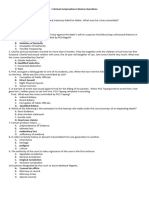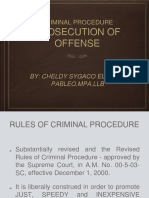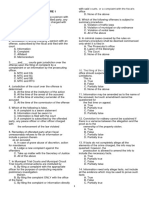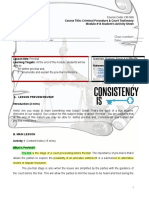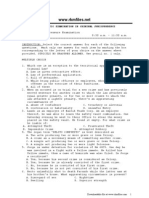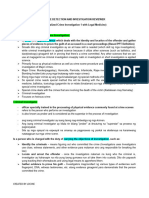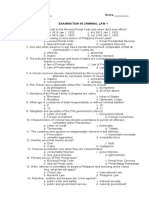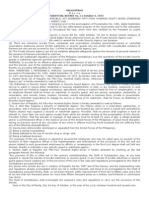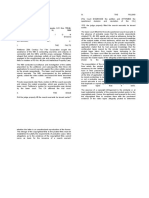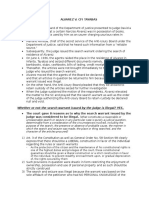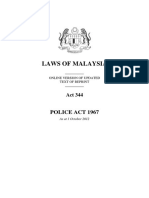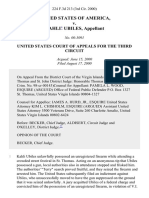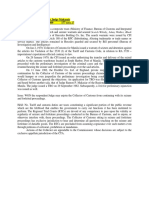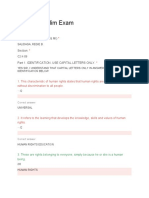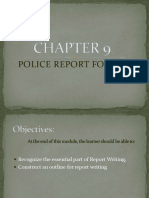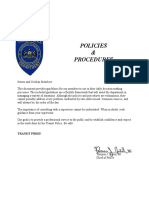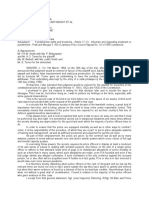100%(1)100% found this document useful (1 vote)
457 views101 pagesCriminal Law Exam Prep
This document contains 30 multiple choice questions regarding criminal jurisprudence, procedure, and evidence. The questions cover topics such as corpus delicti, elements of specific crimes, constitutional provisions regarding search and seizure, arrest procedures, phases of criminal investigation, rules of evidence, and jurisdiction in criminal cases.
Uploaded by
Joshua CastinoCopyright
© © All Rights Reserved
We take content rights seriously. If you suspect this is your content, claim it here.
Available Formats
Download as PPTX, PDF, TXT or read online on Scribd
100%(1)100% found this document useful (1 vote)
457 views101 pagesCriminal Law Exam Prep
This document contains 30 multiple choice questions regarding criminal jurisprudence, procedure, and evidence. The questions cover topics such as corpus delicti, elements of specific crimes, constitutional provisions regarding search and seizure, arrest procedures, phases of criminal investigation, rules of evidence, and jurisdiction in criminal cases.
Uploaded by
Joshua CastinoCopyright
© © All Rights Reserved
We take content rights seriously. If you suspect this is your content, claim it here.
Available Formats
Download as PPTX, PDF, TXT or read online on Scribd
You are on page 1/ 101
CRIMINAL JURISPRUDENCE,
PROCEDURE, & EVIDENCE
CB MOCK
1. Which of the following foregoing statements
refers to “corpus delicti”?
I. Corpus delicti is the body or substance of
the crime.
II. Corpus delicti is the fact that a crime has
actually been committed.
III. Corpus delicti is the body of the person who
is a victim of the homicide or murder.
a. II, III
b. I, II
c. I, III
d. I, II, III
2. What is the crime committed if the offender
killed a person whose age is LESS THAN 12
years of age?
a. Homicide, in the absence of any qualifying
circumstances under Article 248.
b. Murder, if not attended by circumstances
under article 246.
c. Murder, even if the offender is any of the
parent.
d. Parricide, regardless of relationship by
consanguinity.
3. As a general rule, what does the
constitution provide in so far as search
and seizure is concern?
a. Search must be done by the police only.
b. Search must be upon order of the court.
c. Search should be conducted when there is a
warrant.
d. Search must not deprive the person of his
property.
4. The person was arrested without a warrant. His
request for preliminary investigation was granted.
However, the conduct of preliminary investigation
was not terminated and it already exceeded the
period allowed by the rules. What should the police
officer in custody of the detained person do?
a. The police should not release the person, otherwise
he will be administratively liable.
b. The police should release the person from detention
even without the order from the prosecution.
c. The police should not release the person subject to
the receipt of the order of the court.
d. None of these
5. The person is suspected of committing a crime
which is punishable by imprisonment of at
least 4 years, 2 months and 1 day. The person
is not subjected to warrantless arrest. How
will you proceed with the case?
a. Report the matter to my superior and let them
decide what to do with the situation.
b. Exert effort to arrest a person even without a
warrant for the commission of a crime.
c. File a direct complaint with the prosecutor’s
office for inquest proceedings.
d. File a direct complaint with the prosecutor’s
office for preliminary investigation.
6. The PHASE in the commission of the crime
when the person is from the point of
beginning or within the point where he can
still decide to desist or continue the
commission of the crime is the _____ phase.
a. Objective
b. Internal
c. Subjective
d. External
7. The accused is criminal proceedings has in
his favor the rule that criminal laws
should be construed liberally in his favor
because _____.
a. Of the requirement of observance of due
process.
b. The prosecution has the burden of proof.
c. The police is presumed to perform their duty
with regularity.
d. The accused is presumed innocent until
proven guilty.
8. After the decision was rendered by the
trial court, the accused found a new
evidence. What remedy should the accused do
based on the new evidence?
a. File a motion for reconsideration.
b. File a motion for new trial.
c. File a Notice of Appeal.
d. File a Petition for Certiorari.
9. The declaration of an accused acknowledging
his guilt of the offense charged, or of any
offense necessarily included therein is
_____.
a. liability
b. confession
c. admission
d. responsibility
10. A police officer testifying in court is
allowed to refer to his/her notes or
memorandum _____.
a. to help him in the prosecution of the case.
b. In order to refresh his memory.
c. as it is his right as a police officer.
d. as his codigo and his personal record.
11. The constitutional limitation of ex-post
facto law in the enactment of criminal
laws simply means that our criminal law
shall be applied _____.
a. retroactively
b. in favor of the accused
c. prospectively
d. in against the state
12. Preliminary investigation is a matter of
right when the penalty for the crime
committed is _____.
a. not exceeding 6 years of imprisonment.
b. imprisonment at least 4 years, 2 months and
1 day regardless of fine.
c. imprisonment is 4 years, 2 months, and 1 day
regardless of fine.
d. less than 4 years of imprisonment.
13. Police Officer JAKE arrested ACE without
legal ground and without a warrant. JAKE
committed the crime of _____.
a. violation of domicile
b. illegal arrest
c. arbitrary detention
d. unlawful arrest
14. The crime committed is punishable by
imprisonment of at least 4 years, 2 months and
1 day. The crime was committed in Metro Manila
or chartered cities. Where should the complaint
be filed in order to initiate the criminal
action?
a. To file the complaint directly with the
Municipal Trial Court.
b. At the police station for warrantless arrest and
inquest proceedings.
c. At the prosecutors office for the conduct of
preliminary investigation.
d. To file the information directly with the
Regional Trial Court.
15. Which of the following is NOT a secondary
evidence?
a. A testimony of witnesses as to the contents
of the original.
b. A tape recorded recital of the content of
the original.
c. A recital of the contents of the original in
an authentic document.
d. A copy of the original document.
16. What is this rule in evidence which states
that when the terms of an agreement have
been reduced to writing it is considered
as containing all the terms agreed upon
and there can be between the parties and
their successors in interest no evidence
of the written agreement?
a. Secondary evidence
b. Best Evidence Rule
c. Exclusionary Rule
d. Parol Evidence Rule
17. The form of evidence that is subject to
the senses of the court is _____.
a. Physical
b. Object
c. All of these
d. Real
18. The crime committed is punishable by
imprisonment of 4 years, 2 months and less.
The crime was committed in the province.
Where should the complaint be filed in order
to initiate the criminal action?
a. May file the complaint directly with the
Municipal Trial Court.
b. At the police station for warrantless arrest
and inquest proceedings.
c. May file the information directly with the
Regional Trial Court.
d. At the prosecutors office for the conduct of
preliminary investigation.
19. Which of the following circumstances makes
the evidence incompetent?
a. Evidence obtained in accordance with the
constitution.
b. Evidence obtained through third degree
method of investigation.
c. Evidence obtained in accordance with the law
or statute.
d. Evidence obtained in accordance with the
rules.
20. A person who is lawfully arrested may be
searched for anything _____.
a. that the police at its discretion has
deemed to be proper.
b. even if not connected to the commission of
an offense.
c. which may have been used or constitute
proof in the commission of an offense.
d. that may be ordered by the court at its
discretion.
21. What is the purpose why independent
relevant evidence is admitted by courts?
a. To show that a certain fact occurred,
whether true or not.
b. To prove to the court the allegations.
c. To prove that the fact is true.
d. To prove that a fact is not true.
22. When a person is called to testify in court as
an accused, on what matters may the prosecution
cross examine the accused?
I. In matters that was only touched upon in the
direct testimony.
II. In matters surrounding the circumstances of the
crime committed.
III. In all matters that will test the credibility
of the testimony.
a. I, II, III
b. I, II
c. II, III
d. I, III
23. In order that the person accused of a
crime should be bound to answer the
accusation against him, what should the
police officer do?
a. Wait for the issuance of the warrant of
arrest.
b. Let the court proceedings take its course
and allow the issuance of warrant.
c. Arrest the person accused of a crime even
without a warrant.
d. Do the arrest only when requested by the
offended party.
24. Venue in criminal cases refers to the
place _____.
a. of trial where the parties agree.
b. where the trial court designates.
c. that acquired jurisdiction over the case.
d. where the crime was committed.
25. If a person commits an act or omission
which is provided by the Revised Penal
Code as amended or modified, the crime
committed or omitted is _____.
a. crime
b. ordinance
c. offense
d. felony
26. Our criminal law may be applied
extraterritorially which simply means that
_____.
a. our criminal law may be enforced by another
sovereign country.
b. our criminal law may be applicable even
outside of our territory.
c. foreigners here in our country may be
charge for violation of our criminal law.
d. those accused of crime may be arrested even
outside of our territory.
27. The extra-judicial confession of an
accused is sufficient for conviction
_____.
a. provided that it is freely, intelligently
and voluntarily given.
b. when it is corroborated by evidence of
corpus delicti.
c. even if it is not corroborated by evidence
of corpus delicti.
d. whether or not corroborated by evidence of
corpus delicti.
28. Which among the following is NOT
considered as authorized person to file
the complaint before the municipal trial
court?
a. Any peace officer.
b. Any law enforcement officer authorized by
law.
c. The offended party.
d. The witnesses to the crime committed.
29. Which of the following is NOT hearsay?
a. The testimony of a witness concerning the
letter he received from somebody.
b. The information received by a police
officer from the neighborhood regarding the
existence drug dens in the area.
c. The affidavit of a witness who was not
presented to the witness stand for cross
examination.
d. The statement given by the informant to the
police officer.
30. Ped Xing is a Chinese citizen who killed a
Filipino on board a Philippine commercial
vessel on the high seas. Based on the given
situation, based on territoriality principle,
Philippine criminal law is _____.
a. not applicable because the crime was committed
outside of the Philippine territory.
b. not applicable because the offender is not a
Filipino.
c. applicable in this situation although the
crime was committed on the high seas.
d. applicable even if the crime was committed by
a Chinese.
31. The act of omission by a person, who after
hearing or seeing something that requires
him/her to do comment if it is not true,
and was given the opportunity is _____.
a. admission
b. admission against interest
c. confession
d. admission by silence
32. Which of the following situations is NOT a
valid search without a warrant?
a. Search in plain view.
b. Search incidental to stop and frisk.
c. Search at the discretion of a police
officer.
d. Search incidental to lawful arrest.
33. HARDEN after trial was found guilty of a
despicable act. However, the court found
out that there is no law punishing the
said act. May the court punish HARDEN of
any penalty which it deemed appropriate?
a. Yes, the act committed is despicable that
it should be punished.
b. No, the law cannot punish because the court
does not know the applicable law.
c. No, the law cannot punish an act if at the
time it was committed is yet punishable.
d. All of these
34. An act or omission punishable by the
Revised Penal Code is _____.
a. act or omission
b. offense
c. felony
d. crime
35. When the search and seizure conducted by
the police is based on a search warrant,
this presupposes that the search and
seizure _____.
a. may be questionable.
b. is without probable cause.
c. violates the right of the person to
privacy.
d. is with legal ground.
36. JAKE was convicted for several crimes:
Homicide, the penalty imposes is minimum
of 6 years and 1 day to 8 years; Physical
Injuries, the penalty of 4 years and 1 day
to 6 years; and Parricide, the penalty is
Reclusion Perpetua. JAKE should serve
successive service of sentence by serving
first the penalty of _____.
a. any of the conviction
b. 4 years and 1 day to 6 years
c. 6 years and 1 day to 8 years
d. reclusion perpetua
37. What is this right that the accused may
invoke during trial to avoid statement
against himself?
a. Right not to be a witness for his behalf.
b. Right against self-incrimination.
c. Right to assistance of counsel.
d. Right to remain silent.
38. The power or authority to hear and decide
a case is _____.
a. judicial
b. jurisdiction
c. venue
d. mandate
39. The reading of the decision of the court
convicting the accused appears to be NOT
based on evidence on record or applicable
law. What remedy should the accused do in
the hope that the court may reverse its
decision?
a. File a motion for reconsideration.
b. File a Notice of Appeal.
c. File a motion for new trial.
d. File a Petition for Certiorari.
40. In arbitrary detention it is required that
the offender must be a _____.
a. a person in authority or agent.
b. any person.
c. a public officer or employee.
d. private individual.
41. The venue to hear criminal cases may be
changed when the _____.
a. prosecution and the accused agree.
b. complainant opted to change it.
c. trial court so ordered
d. Supreme Court so ordered
42. When a Filipino kills a Chinese on board a
vessel bearing the flag of Mexico while
the vessel is in the Philippine waters,
may the criminal law of the Philippines
apply?
a. Yes, the Philippine criminal law is
applicable.
b. Yes, since the offender is a Filipino.
c. No, it is the Mexican criminal law that
applies.
d. No, the Philippine criminal law is not
applicable.
43. If the crime is committed in the province
and the penalty thereof is one that does
NOT require preliminary investigation, the
complaint shall be filed _____.
a. directly with the appropriate Municipal
Trial Court.
b. at the Prosecutor’s Office for inquest
proceedings.
c. directly with the appropriate Regional
Trial Court.
d. in the barangay first for conciliation
proceedings.
44. To produce conviction, the extra-judicial
confession must be supported by _____.
a. the testimony of the counsel who assisted
during the investigation.
b. the testimony of the accused affirming his
extra-judicial confession.
c. the testimony of the investigating officer
who obtained the confession.
d. the presentation of corroborative evidence
of corpus delicti.
45. The following are elements of FRUSTRATED
stage in the commission of the crime,
EXCEPT _____.
a. the acts performed would produce the felony
as a consequence.
b. but the felony is not produced.
c. by reason of spontaneous desistance of the
accused.
d. the offender performs all acts of
execution.
46. Which of the following is NOT among the
exceptions to the hearsay evidence?
a. Learned treatise
b. Commercial lists
c. Dead man statute rule
d. Entries in official records
47. The accused with lewd design brought the
woman who is a minor in a secluded place
but with the consent of the latter. The
accused is liable for the crime of _____.
a. simple seduction
b. forcible abduction
c. qualified abduction
d. consented abduction
48. Rebellion and coup d’ etat when committed
by military personnel will subject them to
court martial proceedings. What is the
NATURE of court martial proceedings?
a. Civil
b. Administrative
c. Sui generis
d. Criminal
49. The process required to determine probable
cause based on direct filing of a
complaint so that the information may be
filed in court is _____.
a. ex-parte examination of the complaint.
b. preliminary investigation.
c. inquest proceedings.
d. judicial determination of probable cause.
50. During arraignment, the accused is required
to enter his plea. So that the accused may
be intelligently understands the
consequences of his plea, what is the
mandatory requirement in entering the plea?
a. The accused should be assisted by his
witnesses.
b. The accused should be assisted by the court
of competent jurisdiction.
c. The prosecution should offer lower and
irresistible offer.
d. The accused should be assisted by competent
and independent counsel.
51. Mistake of facts is distinguished from
mistake in identity in that in mistake of
facts the _____.
a. offender has the intention to commit the
crime.
b. accused is certain about who is the victim.
c. accused is without intention to commit a
felony.
d. offender is related to the victim.
52. When a crime is committed on board a US
Warship while it is on Philippine waters,
the _____.
a. Philippine criminal law shall not be
applicable.
b. US military law shall be applicable.
c. US criminal law shall be applicable in our
courts.
d. Philippine criminal law shall be
applicable.
53. The person was arrested without a warrant for
the crime the penalty of which is imprisonment
of at least 4 years, 2 months and 1 day. He
asked for preliminary investigation. What is
required of the person arrested in order that
preliminary investigation may be conducted?
a. He should ask for the presence of the counsel
while being detained.
b. He should ask for his right to remain silent in
the course of the preliminary investigation.
c. He should ask his right to be informed of the
nature of the cause and accusation against him.
d. He should waive his rights under Article 125 of
the Revised Penal Code.
54. When a case is filed in this court, bail
becomes a matter of right before or after
conviction, which court is it?
a. Regional Trial Court
b. Municipal/Metropolitan Trial Court
c. Court of Appeals
d. Sandiganbayan
55. ACE is a police officer. He arrested JAKE
without a warrant for a crime which is
considered as less grave offense. For ACE
to be NOT liable for the crime of
arbitrary detention, he must deliver JAKE
to the proper judicial authorities within
_____.
a. 12 hours
b. 18 hours
c. 36 hours
d. 32 hours
56. The police officer testifying in court can
refer to his/her notes or memorandum
_____.
a. as his codigo and his personal record.
b. as it is his right as a police officer.
c. in order to refresh his memory.
d. to help him in the prosecution of the case.
57. The crime committed when a person killed
his/her illegitimate daughter who is a
minor under the circumstances provided by
Article 246 is _____.
a. infanticide
b. murder
c. homicide
d. parricide
58. The constitutional limitation of bill of
attainder in the enactment of criminal
laws simply means that our criminal law
shall _____.
a. decrease the imposed penalty to favor the
accused.
b. imposed the penalty even without hearing
and trial.
c. applied the penalty only sparingly in favor
of the state.
d. impose the penalty only after due hearing
and trial.
59. The prosecution shall offer in evidence
its documentary evidence _____.
a. at any time the prosecution may deep proper
at its discretion to offer.
b. after the presentation of testimonies of
witnesses have been terminated.
c. None of these
d. after the presentation of the witnesses of
the defense are terminated.
60. The crime of adultery is committed by any
married woman who shall _____.
a. have sexual intercourse with a man under
scandalous circumstances.
b. enter into marriage with another man other
than her husband.
c. have sexual intercourse with a man who is
not her husband.
d. live in conjugal dwelling with a man who is
not her husband.
61. Because the burden of proof rests with the
prosecution, the duty to convict the
person belongs to _____.
a. None of these
b. the strength of the prosecution’s evidence.
c. the courts discretion based on evidence.
d. the weakness of the accused’s evidence.
62. The new and independent act which is the
immediate cause of the injury which breaks
the connection between the original wrong
and the injury is referred to as the _____
cause.
a. effective intervening
b. causal connecting
c. efficient intervening
d. efficient connecting
63. LINO saw ACE with an angry expression on his
face while holding a firearm moving towards his
direction. When ACE was already near him, LINO
picked up a 2x2 hard wood and hit ACE on both
his arms, resulting injuries to the latter. It
was revealed during the investigation that ACE
is without bad intention against LINO. LINO was
charged for serious physical injuries. This
situation fits the principle of _____.
a. mistake in identity.
b. mistake in the blow.
c. mistake of facts.
d. ignorance of the law.
64. Which of the following illustration BEST
exemplifies the concept of complex crimes?
a. HARDEN wanted to kill CURRY. HARDEN set the
house of CURRY resulting to the death of
CURRY.
b. HARDEN steal the chicken of CURRY, while at
it, took the chicken of PAUL and that of
DURANT.
c. HARDEN killed CURRY, after a week, raped PAUL
and later steal the chicken of DURANT.
d. HARDEN wanted to kill CURRY. He threw a
grenade against CURRY. It killed CURRY and
injured DURANT.
65. Exclusion of evidence simply means _____.
a. None of these
b. that evidence obtained unlawfully shall be
excluded by the court and not admitted.
c. that evidence which are testimonial but
objectionable shall be excluded.
d. that witnesses not subject for examination
should be excluded from the court.
66. A person who is committing an act in
violation of a special penal law is
committing _____.
a. a crime.
b. an offense.
c. a felony.
d. an act or omission.
67. What is this STAGE in court proceedings
where the prosecution and accused may
agree on matters that will promote a fair
and expeditious trial of the case?
a. Trial proper
b. Preliminary investigation
c. Inquest proceedings
d. Pre-trial
68. A Filipino killed a Chinese on board a
vessel bearing the flag of Mexico while
the vessel is in Philippine territorial
waters, should the criminal law of the
Philippines apply?
a. No, because the crime was committed board a
Mexican vessel.
b. Yes, because the crime was committed within
the Philippine territory.
c. Yes, because the offender is a Filipino.
d. No, because the offended party is a
Chinese.
69. A police officer testifying before the
court is allowed to refer to his/her
memorandum respecting a matter of _____.
a. opinion of an expert.
b. fact recorded by his superior.
c. fact he recorded a long time ago.
d. question of law.
70. The place of the commission of the crime
is a consideration to determine the _____.
a. territory
b. venue
c. area of responsibility
d. jurisdiction
71. The party is deemed to have rested its
case _____.
a. once the parties agreed as stated in the
pre-trial.
b. as may be ordered by the court.
c. after the court ruled on the formal offer
of evidence.
d. after the prosecution has offered its
evidence.
72. What is the form of evidence consisting of
letters, symbols, numbers or any
inscription?
a. Parole evidence
b. Original evidence
c. Best evidence
d. Documentary evidence
73. The following are the sources of criminal
law, EXCEPT _____.
a. Special Laws
b. Ordinances
c. Special Penal Laws
d. Revised Penal Code
74. Conclusive presumption is also known as
“presumption juris et de jure”; disputable
presumption is _____.
a. presumption of regularity
b. dying declaration
c. presumption of innocence
d. presumption juris tantum
75. The questioning initiated by law
enforcement authorities after a person is
taken into custody or otherwise deprived
of freedom of action is _____.
a. illegal detention
b. arbitrary detention
c. custodial investigation
d. preliminary investigation
76. The authority to enact national penal
statutes is lodged in the _____.
a. respective Sanggunian of LGUs.
b. respective Mayors of LGUs.
c. Congress of the Philippines.
d. trial courts in the Philippines.
SITUATION 1: CLARKSON is an investigator. CURRY is the
suspect. NANCE is the victim with stab wounds. The
identified witness to the crime committed is DURANT.
77. From the foregoing situation, suppose that DURANT has
personal knowledge of the crime committed. However,
DURANT has been previously convicted for the crime of
robbery. Which of the following statements BEST
describes the qualification of DURANT as a witness?
a. He is not competent to testify because of his previous
conviction.
b. He is qualified to testify subject to the approval of
the court.
c. He is qualified to testify subject to the approval of
the court.
d. He is qualified to testify despite his conviction of the
crime of robbery.
78. From the foregoing situation, suppose that
DURANT is merely 6 years old. Which of the
following statements BEST describes the
qualification of DURANT as a witness?
a. He is qualifies so long that he can express
his thought before the court.
b. He is not qualified because a minor is
susceptible of being coached by lawyers.
c. He is not qualified because he is still a
minor.
d. He is qualified because he can perceive and
perceiving can convey his perception to
another.
79. From the foregoing situation, suppose that
DURANT merely heard from KERR the information
that it was CURRY who killed NANCE. Which of
the statements below CORRECTLY describes the
admissibility of DURANT’s testimony?
a. The testimony is admissible if only supported
by other evidence.
b. The testimony is not admissible as it is a
declaration against interest.
c. The testimony is admissible only as
independent relevant statement.
d. The testimony is not admissible as it serves
only his own interest.
80. From the foregoing situation, suppose that
DURANT merely heard from KERR the information
that it was JAMES who killed NANCE. Which of
the statements below correctly describes the
admissibility of DURANT’s testimony?
a. It is not admissible for being independent
relevant statement.
b. It is admissible if it is being supported by
evidence of corpus delicti.
c. It is admissible if DURANT qualifies as a
witness.
d. It is not admissible for being hearsay
evidence.
Situation 2: PO3 CARDO apprehended WALDO due
to vehicular traffic incident.
81. From the foregoing situation, suppose that
WALDO ignores the authority of PO3 CARDO.
The latter reacted by angrily staring at
WALDO draws his firearm but without
pointing it to WALDO. Which of the
following crimes may PO3 CARDO be liable?
a. Grave coercion
b. Light threats
c. Less grave coercion
d. Grave threats
82. From the foregoing situation, suppose that
PO3 CARDO draws his firearm and discharged
it in the air because he saw WALDO running
away from the area of the incident. Which
of the following crimes may PO3 CARDO be
liable?
a. Illegal discharge of firearm
b. Grave coercion
c. Alarms and scandals
d. Grave threats
83. From the foregoing situation, suppose that
PO3 CARDO draws his firearm, points it to
WALDO, discharged it without intent to
kill WALDO, and without hitting WALDO.
Which of the following crimes may PO3
CARDO be liable?
a. Attempted homicide
b. Attempted murder
c. Illegal discharge of firearm
d. Attempted serious physical injury
84. From the foregoing situation, suppose that
PO3 CARDO points the firearm to WALDO and
discharge it but without intent to kill.
It did not hit WLADO, however, it hit
ARIANNE, the girlfriend of WALDO. ARIANNE
suffered a fatal injury but survived.
Which of the following crimes is PO3 CARDO
liable?
a. Frustrated homicide
b. Serious physical injury
c. Frustrated murder
d. Illegal discharge of firearm
Situation 3: FRANKLIN is the warden of the Pambansang
Kulungan ng mga Lords (Pakulo). PETER is a detainee. JAYBEE
is a convict. JONEL is a custodial guard.
85. From the foregoing situation, suppose that LEILA, a very
influential private individual arranged with FRANKLIN
and JONEL the escape of PETER in exchange for certain
consideration. PETER indeed escaped. Which of the
following crimes may be committed by FRANKLIN and JONEL?
a. Direct bribery resulting in evasion of service of
sentence.
b. Direct bribery and infidelity in the custody of the
prisoner.
c. Conspiracy to the crime of evasion of service of
sentence.
d. Infidelity in the custody of prisoner through
negligence.
86. From the foregoing situation, suppose that
PETER escaped from PAKULO through his own
efforts without giving any consideration to
FRANKLIN and JONEL. Did PETER commit any
crime?
a. No, not yet for the crime of delivery of
prisoner from jail.
b. No, he did not commit any crime under the
RPC.
c. Yes, for the crime of delivery of prisoner
from jail.
d. Yes, for the crime of evasion of service of
sentence.
87. From the foregoing situation, suppose that
JAYBEE escaped through his own efforts
from PAKULO without giving consideration
to FRANKLIN and JONEL? What is the crime
committed by FRANKLIN and JONEL?
a. Conspiracy to the crime of evasion of
service of sentence.
b. Conspiracy for the crime of delivery of
prisoner from jail.
c. Delivery of prisoner from jail.
d. Infidelity in the custody of prisoner.
88. From the foregoing situation, suppose that
JAYBEE escaped through his own efforts
from PAKULO without giving consideration
to FRANKLIN and JONEL. Did JAYBEE commit
any crime?
a. Yes, for failure to honor his bail bond.
b. No, as he did not bribe FRANKLIN and JONEL.
c. Yes, for delivery of prisoner from jail.
d. Yes, for evasion of service of sentence.
Situation 4: Hipolito was brought to the police station
by Corporal Cardo Dalisay for the crime of rape. While
being investigated, Hipolito remained silent.
89. From the foregoing situation, what is the effect of
Hipolito’s remaining silent while being interviewed
by the police in connection with the crime
committed?
a. Hipolito should answer after all evidence he gave
will be inadmissible.
b. Hipolito is within his Constitutional right to remain
silent.
c. Hipolito may still answer even when there is a
counsel provided to him.
d. Hipolito’s silence is deemed admission of guilt.
90. From the foregoing situation, which of the
following is the reason why Hipolito may
or may not remain silent?
a. Any statement made by Hipolito will be
deemed inadmissible anyway.
b. Hipolito is already under custodial
investigation.
c. Hipolito may speak whether or not assisted
by a counsel.
d. Hipolito is not yet under custodial
investigation.
91. From the foregoing situation, when should
Hipolito be informed of Miranda rights?
a. Before he is put into custody.
b. After he was asked any question related to
the crime he was arrested for.
c. Immediately after he is arrested.
d. When he is already assisted by a counsel of
his choice or as provided for.
92. From the foregoing situation,
jurisprudence declares that the suspect
may waive his right to remain silent under
the following, EXCEPT it must be _____.
a. in the presence of counsel.
b. in writing.
c. before the prosecutor’s office.
d. after the Miranda rights was given to him.
Situation 5: Pinuno is the Philippine
Ambassador deployed to the Republic of Japan.
93. From the foregoing situation, suppose that
while in the performance of his office,
Pinuno committed an act punishable under
the Philippine penal laws, the
characteristics of criminal law to be
applied should be _____.
a. Generality
b. Extra-territoriality
c. International law
d. Territoriality
94. From the foregoing situation, suppose that
Pinuno is a Japanese and the Ambassador of
Japan to the Philippines. Outside the
performance of his public office, Pinuno
committed an act which is punishable under
Philippine law, the characteristics or
criminal law to be applied should be
_____.
a. Prospectivity
b. Generality
c. Extra-territoriality
d. Territoriality
95. From the foregoing situation, suppose that
Ambassador Pinuno committed an act which
under the law of Japan is considered as
penal, can the government of Japan
prosecute Pinuno?
a. No, Pinuno is exempt from the application
of Japan criminal law.
b. No, the crime was committed in Japan, their
criminal law applies.
c. Yes, under the extra-territoriality
characteristics or our criminal law.
d. None of these
96. From the foregoing situation, suppose that
Pinuno is just an ordinary Embassy employee
in Japan. He committed a crime in connection
with the performance of his official
function. The act complained of is not yet
punishable at the time it was committed.
Under our penal system, the applicable
characteristic of criminal law is _____.
a. Territoriality
b. Internationally
c. Prospectivity
d. Generality
Situation 6: OSCAR is a police officer.
HIPOLITO is the offender. ERIKA is the victim.
97. From the foregoing situation, suppose that
HIPOLITO in the commission of the crime of
murder against ERIKA ensured that ERIKA
cannot retaliate or cause harm against the
former, what is the applicable modifying
circumstance?
a. Exempting
b. Aggravating
c. Alternative
d. Mitigating
98. From the foregoing circumstance, suppose
that HIPOLITO used the presence of 4 of
his relatives to ensure that ERIKA cannot
retaliate against HIPOLITO at the time he
inflicted physical injuries against ERIKA,
what is the applicable modifying
circumstance?
a. Exempting
b. Mitigating
c. Alternative
d. Aggravating
99. From the foregoing circumstance, suppose
that ERIKA is a woman. HIPOLITO took
advantage of his position as he is also a
police officer so that she was able to
have carnal knowledge against the will of
ERIKA. What is the applicable modifying
circumstance?
a. Exempting
b. Mitigating
c. Aggravating
d. Alternative
100. From the foregoing situation, suppose that
despite due diligence, and without
intention to commit a crime, and without
fault, the act of HIPOLITO resulted in
physical injuries against the person of
ERIKA, what is the applicable modifying
circumstance in this case?
a. Aggravating
b. Alternative
c. Exempting
d. Mitigating
You might also like
- Compiled Review Questions in Criminal JurisprudenceNo ratings yetCompiled Review Questions in Criminal Jurisprudence9 pages
- Criminal Procedure: Prosecution of OffenseNo ratings yetCriminal Procedure: Prosecution of Offense62 pages
- August2023 - Lea FC by Prof. Santos - Ans. KeyNo ratings yetAugust2023 - Lea FC by Prof. Santos - Ans. Key31 pages
- Test Drill in Criminal Procedure and Court TestimonyNo ratings yetTest Drill in Criminal Procedure and Court Testimony49 pages
- Diagnostic Examination in Criminal Jusrisprudence100% (1)Diagnostic Examination in Criminal Jusrisprudence12 pages
- Crime Detection and Investigation ReviewerNo ratings yetCrime Detection and Investigation Reviewer14 pages
- Criminal Law 1 Final Examination AU Without AnswerNo ratings yetCriminal Law 1 Final Examination AU Without Answer17 pages
- Criminal Jurisprudence and Procedure Set OneNo ratings yetCriminal Jurisprudence and Procedure Set One45 pages
- Mock Board Examination 2016: Social ConflictNo ratings yetMock Board Examination 2016: Social Conflict10 pages
- Criminal Law Exam: Key Concepts & ScenariosNo ratings yetCriminal Law Exam: Key Concepts & Scenarios37 pages
- Criminal Jurisprudence Procedure and EvaluationNo ratings yetCriminal Jurisprudence Procedure and Evaluation19 pages
- Unit 1 - The Crime Scene Cheat Sheet: by ViaNo ratings yetUnit 1 - The Crime Scene Cheat Sheet: by Via2 pages
- United States v. Kahli Ubiles, 224 F.3d 213, 3rd Cir. (2000)No ratings yetUnited States v. Kahli Ubiles, 224 F.3d 213, 3rd Cir. (2000)10 pages
- RSE.2018 Remedial Law Bar Suggested Answersv285% (47)RSE.2018 Remedial Law Bar Suggested Answersv219 pages
- People v. Reynaldo Belocura, G.R. No. 173474, Aug. 29, 2012No ratings yetPeople v. Reynaldo Belocura, G.R. No. 173474, Aug. 29, 201215 pages
- Efren H. Mercado For Petitioners in G.R. No. 81567 and G. R. No. 83162No ratings yetEfren H. Mercado For Petitioners in G.R. No. 81567 and G. R. No. 8316232 pages
- Commissioner of Customs Vs Judge MakasairNo ratings yetCommissioner of Customs Vs Judge Makasair1 page
- G.R. No. 244045, People Vs Guerrero - June 16, 2020No ratings yetG.R. No. 244045, People Vs Guerrero - June 16, 202069 pages
- Merson v. Cartwright: Bahamas SC RulingNo ratings yetMerson v. Cartwright: Bahamas SC Ruling38 pages










